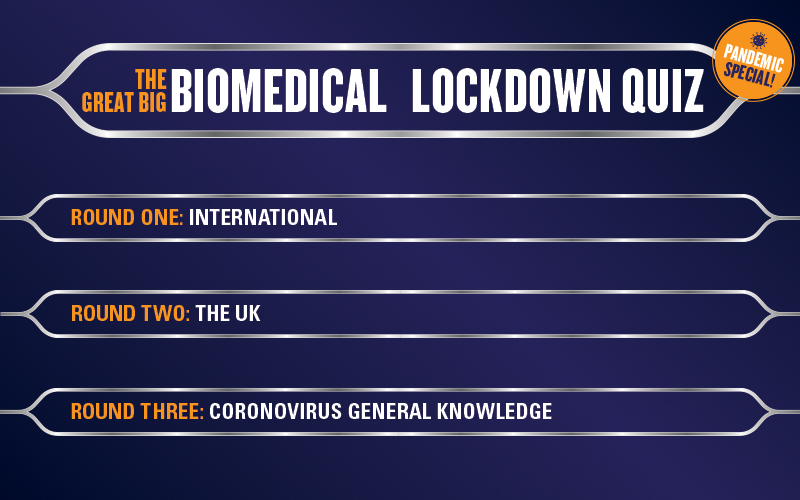The final instalment of our biomedical science quiz for 2020. This time, we have three rounds testing members’ knowledge of the pandemic. Click on the link at the bottom of the quiz to see the answers.

In the first couple of months of 2020, it seemed that Brexit and the environment were going to dominate the news agenda for the year. Then the coronovirus outbreak in Wuhan changed everything. Believed to be from a wet market in the city, the outbreak became an epidemic, then a pandemic and the globe was the thrust into lockdowns, social distancing and daily headlines reporting death rates, transmission rates and potential hopes for a return to normal life through medical innovation or unique social solutions. It has been a year like no other.
Looking back at the year
As 2020 draws to a close, and newspaper headlines focus on whether families and friends will be reunited at Christmas and what hopes there are for immunity in the new year, we look back over the last 12 months with 30 questions.
Round one: International
- A consumer rights group is taking legal action against which government over COVID-19 outbreaks at ski resorts in March?
- In April, Donald Trump suggested that injecting what substance into the body could be used to help treat COVID-19?
- The President of which country said: “The virus is here, we’re going to have to confront it. Confront it like a man, not a boy... We're all going to die one day”?
- As of November, which Scandinavian country had the cumulative highest number of coronavirus cases?
- Which country has the highest number of deaths per 100 confirmed cases (observed case-fatality ratio) according to the Johns Hopkins University?
- In November, the UK imposed a ban on non-UK citizens coming from Denmark amid concerns over a new coronavirus strain that had spread to humans from which animals?
- In August, which president said a vaccine developed is his country had passed all the required checks and it had been given to one of his own daughters?
- In June, telecoms masts were pulled down and destroyed in a country for fears that 5G technology could transmit coronavirus (despite the fact the country had no 5G network). Which country was this?
- From April to June, which Central American country tried to curb the pandemic by requiring women and men to remain at home on alternate days?
- Which country, neighbouring Iran, had not, as of November, confirmed a single case of coronovirus (there are claims that this is because the government banned the word)?
Round two: The UK
- In which month were the first two cases of coronavirus confirmed in the UK?
- Where was the first British citizen confirmed to have died of COVID-19 at the time of death?
- In March it was announced weekly episodes of which soap would be reduced from four to two to keep it on the air for as long as possible?
- Which was the first UK city to enter a local lockdown?
- Where did Boris Johnson’s former Chief Advisor Dominic Cummings drive to on his wife’s 45th birthday – while recovering from suspected coronavirus – to “check his eyesight”?
- In which month did the UK surpass Italy to become the country with the highest declared death toll in Europe, with more than 32,000 fatalities?
- Which member of the royal family cancelled their wedding reception at Buckingham palace due to coronavirus?
- On 18 May what did the government announce was being added to the official list of coronovirus symptoms?
- Who was the first Member of Parliament to test positive for coronavirus?
- Who was due to headline the Sunday night of this year’s cancelled Glastonbury festival (it would have been their debut at the event)?
Round three: Coronavirus general knowledge
- In 1931, Arthur Frederick Schalk and Merle C Fawn at the North Dakota Agricultural College were the first to report what was later identified as coronavirus disease. In which animals was it found?
- In which decade were coronaviruses first discovered in humans?
- There are four main sub-groupings of coronaviruses, what are these?
- What does the acronym “SARS” stand for in SARS-CoV-2?
- What does the “19” stand for in COVID-19?
- SARS was first discovered in February 2003, in an outbreak that lasted approximately six months and which the WHO says reached 29 countries. What was its country of origin?
- MERS-CoV was first identified in Saudi Arabia in 2012 and an estimated 35% of reported patients died. Which animal is believed to have transmitted the virus to humans?
- On average how many spikes does a coronavirus particle have (answers within a range of 10 accepted)?
- Infection begins when which element of the particle attaches to its complementary host cell receptor?
- In July, a cat from Weybridge was confirmed as the first animal in the UK to test positive for COVID-19. What was its name?




